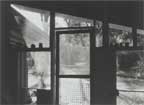The Farmers Market Share
 On Earth Day, regulars of the Santa Cruz Downtown Farmers Market wandered into a dazzling feast of new sights and smells. On tree-shaded aisles occupied the previous week by parked cars, the aromas of rotisserie chicken and hot pizza mingled while shave-ice vendors hawked the flavors of the tropics. Next to an array of colorful dishware by master ceramicist Mattie Leeds, the knife sharpener in his thick apron joked with visitors. The strains of bluegrass by Harmony Grits drifted off the new stage, background to the hiss of the Lulu Carpenter’s espresso machine and the chatter at information booths and the fishmonger’s. And anchoring it all, of course, were three aisles of farm-fresh fruits, vegetables, herbs and flowers, the bustling heart of the market.
On Earth Day, regulars of the Santa Cruz Downtown Farmers Market wandered into a dazzling feast of new sights and smells. On tree-shaded aisles occupied the previous week by parked cars, the aromas of rotisserie chicken and hot pizza mingled while shave-ice vendors hawked the flavors of the tropics. Next to an array of colorful dishware by master ceramicist Mattie Leeds, the knife sharpener in his thick apron joked with visitors. The strains of bluegrass by Harmony Grits drifted off the new stage, background to the hiss of the Lulu Carpenter’s espresso machine and the chatter at information booths and the fishmonger’s. And anchoring it all, of course, were three aisles of farm-fresh fruits, vegetables, herbs and flowers, the bustling heart of the market. Last week the Santa Cruz Downtown Farmers Market gave itself a 20th birthday gift by launching a long-awaited expansion on Earth Day. Now stretching from Lincoln Street to Cathcart, the vibrant Wednesday afternoon destination for local and regionally harvested organic products has been enlarged by 20 purveyors, live music, valet services for bicycles and for retrieval of purchases, an arts and crafts section and an organic food court. The new section of the market fills the parking lot at Cathcart and Cedar behind the University Town Center and hosts informational booths representing nonprofits such as Slow Food, Seafood Watch, Save our Shores, LifeLab and Ecology Action, to name just a few. And yes, there are expanded restroom facilities and just plain more space in which to move around, hang out and do some serious shopping.
For the past nine years Nesh Dhillon has been operations manager for the Santa Cruz Certified Farmers Markets, a job for which he admits that “deep breathing skills” are a prime requirement. He says the new expansion has been building for years. “We are trying to have a diverse shopping experience for the consumer,” he says, “so we have new arts and crafts booths, soap vendors, a permanent massage booth and artisan booths selling prepared food like sauerkraut and jams.” Two or three new farmstands will also be integrated into the mix, Dhillon says, adding variety to the fruits and vegetables.
For would-be locavores, good news comes in the form of several regional producers who are bringing in items not available within our immediate foodshed. Old Creek Ranch, based in Cayucos (near San Luis Obispo), will bring in pasture-raised, hormone-free beef, lamb, goat and pork, as well as citrus fruits and avocados. Massa Organics, based in the Chico area, will offer certified organic brown rice and almonds. And on the prepared foods front, RoliRoti’s Thomas Odermatt, a third-generation butcher/chef headquartered in the Bay Area, will be roasting rotisserie chickens on-site and selling them by the half and by the whole along with roasted potatoes.
Across the nation, farmers markets have blossomed in every conceivable locale, from Memphis, Tenn. (in 2007 named the United States’ most obese city) to Fairbanks, Alaska (one of its northernmost). These days, markets have star power on their side. Not only does every single chef on the Food Channel make a point of establishing his or her street cred with footage of delighted strolls through farmers markets, but political animals are getting in on the act as well. In September, First Lady Michelle Obama helped push through permits for a farmers market just in front of the White House lawn, smack in the middle of the federal district.
The rapid proliferation of farmers markets is staggering. The USDA estimates that in 1994 there were approximately 1,750 farmers markets nationwide. Today there are more than 5,000. That 300 percent increase means that direct marketing of freshly harvested farm products is not only wildly popular, it’s becoming an important source of income for small farmers—even if it’s rarely enough.
“Most farmers I know are doing more than just farmers markets,” says Gail Feenstra, a food systems analyst at UC-Davis. “They’re looking at other marketing venues that don’t include quite as much investment in terms of time and gas and so on. But farmers markets continue to grow ,and I think they probably will for a while because there’s just so much demand out there for local food,” she says. “It’s way more than it used to be even five years ago.”
In this area, says Dhillon, “Most farmers sell through CSAs, direct to restaurants and at farmers markets, and obviously most profits are made at farmers markets.” For that opportunity, market members pay an annual fee. Dhillon says it varies, but it’s usually about $130 per year, plus a daily stall fee of $35–$50. After all, he contends, the market costs the downtown in fees to the city, in parking attendant fees and in taxes. “It’s not a free ride,” he says, “and I, for one, don’t think it should be.”
Naturally, California was on the cusp of the movement. Markets started popping up around the state 30 years ago. In 1990, Santa Cruz joined the party. “So we were really on the forefront,” says Dhillon.
Of the five markets in the SCCFM family, which includes the Westside, Live Oak, Scotts Valley and Felton markets, the Downtown Market is the eldest sibling. Now with 70 vendors, it’s comparable in size to the two largest markets on the Monterey Bay, the 82-member Monterey Farmers Market and the 80-vendor Aptos Farmers Market held Sundays at Cabrillo.
Dhillon credits two dynamics—pressure from the farming community (Exhibit A being the long waiting list of farms trying to get into the market) and consumers feeling crowded—for creating last week’s growth spurt. “And I gotta say,” he chuckles, “everybody has been so supportive—the city, the Chamber of Commerce, the business community, the City Council.” Making the expansion all the easier was the fact that the city was already acclimated to having the Wednesday market here. “They were used to having traffic and parking issues,” he says, “so it was a logical move to simply expand and add the next parking lot.”
Rebecca King of Garden Variety Cheeses, for whom farmers markets are the primary sales outlet, looks forward to having a bigger booth for her handmade sheep cheeses and lamb sausage. “I’m excited about the larger market—more customers and more places to sit and eat,” she says. “It is more appealing to those who are really here to shop.”
Live Earth Farm owner Tom Broz agrees that the expansion “was a great thing just waiting to happen. The farmers market is really central to Santa Cruz,” he says. “While we have a large CSA, the farmers market is a great way to bring our food direct to the consumer.”
For his part, Dhillon is thrilled with the blend of sensory experiences available at the up-sized venue. “There will finally be a music series, like at the Westside market,” he points out. Arts and crafts booths will appear courtesy a pilot arrangement with the Tannery Arts Center (it will be evaluated at the end of the year). As far as the exuberant hippie fringe—which on the first day of the new farmers market took up position at the parking lot behind Petroglyph, across from Jack’s—Dhillon remains philosophical. “The patchouli drummers just go with the Santa Cruz scene,” he says.
As for the future? “To launch into the very top level of national markets, we need to launch into food education,” he says. “So we’ve begun working with Ecology Action and Slow Food Santa Cruz—that’s just part of a whole wave of exciting events planned for downtown.”
At its most basic, though, the farmers market is a vibrant part of the local community, and one that defies the usual trends. “It speaks volumes that in times where most things are contracting, we’re actually expanding,” says Dhillon, “and it’s because of the success of the farmers markets. It’s amazing that we’re able to do this.”
Also in food news this week: Santa Clara's Happy Meal Law & FDA Salt Comments.






























0 Comments:
Post a Comment
<< Home